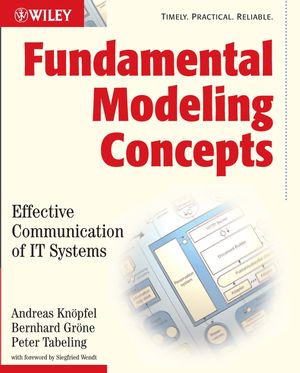Fundamental Modeling Concepts: Effective Communication of IT SystemsISBN: 978-0-470-02710-3
Paperback
352 pages
April 2006
 This is a Print-on-Demand title. It will be printed specifically to fill your order. Please allow an additional 10-15 days delivery time. The book is not returnable.
|
||||||
Preface.
1 Introduction.
1.1 The need for communication.
1.2 The FMC Idea.
1.3 Outline of this book.
2 Compositional Structures.
2.1 An example: The travel agency.
2.2 Modeling the structure of a system.
2.3 Agents accessing storages.
2.4 Agents communicate via channels.
2.5 Summary.
2.6 Exercises.
3 Dynamic Structures.
3.1 Petrinets: Basic principles.
3.2 Conflicts and conditions.
3.3 Basic patterns.
3.4 Responsibilities and scope boundaries.
3.5 Summary.
3.6 Exercises.
4 Value Structures and Mind Maps.
4.1 Entity sets and relationships.
4.2 Cardinalities.
4.3 Predicates and roles.
4.4 Partitions.
4.5 Reification.
4.6 Summary.
4.7 Exercises.
5 FMC Basics: Summary.
6 Reinforcing the Concepts.
6.1 The meta model: A mind map to FMC.
6.2 Operational versus control state.
6.3 Block diagrams: Advanced concepts.
6.4 Petrinets: Advanced concepts.
6.5 Non-hierarchical transformations and semantic layers.
6.6 Exercises.
7 Towards Implementation Structures.
7.1 System structure versus software structure.
7.2 From Processor to processes.
7.3 Distribution, concurrency and synchronization.
7.4 From FMC to objects and classes.
7.5 Conceptual patterns versus software patterns.
8 Applying FMC in Your Daily Work.
8.1 Becoming comfortable with FMC.
8.2 Describing existing systems with FMC.
8.3 Using FMC in construction.
8.4 Using FMCdiagrams to support communication.
8.5 Guidelines for didactical modeling.
8.6 Cost and benefit of modeling.
9 Modeling and Visualization Guidelines.
9.1 Introduction.
9.2 Increasingt he reader’s perception.
9.3 Increasing comprehension.
9.4 Secondary notation, patterns and pitfalls.
10 Relationship with Other Modeling Approaches.
10.1 Comparing FMC with Structured Analysis.
10.2 FMC and the Unified Modeling Language.
11 A System of Server Patterns 247
11.1 Applicationdomain.
11.2 A pattern language for request processing servers.
11.3 Example applications.
11.4 Conclusion and further research.
Epilogue.
A Solutions.
B Reference Sheets.
C Glossary.
References.
Index.



